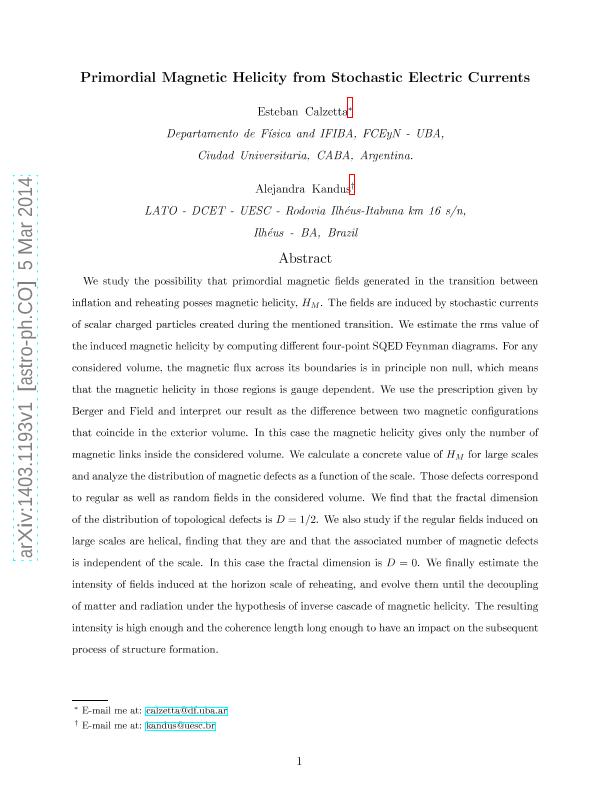Mostrar el registro sencillo del ítem
dc.contributor.author
Calzetta, Esteban Adolfo

dc.contributor.author
Kandus, Alejandra
dc.date.available
2017-06-08T21:40:18Z
dc.date.issued
2014-04
dc.identifier.citation
Calzetta, Esteban Adolfo; Kandus, Alejandra; Primordial magnetic helicity from stochastic electric currents; American Physical Society; Physical Review D; 89; 8; 4-2014; 1-32; 083012
dc.identifier.issn
0556-2821
dc.identifier.uri
http://hdl.handle.net/11336/17855
dc.description.abstract
We study the possibility that primordial magnetic fields generated in the transition between inflation and reheating posses magnetic helicity, HM. The fields are induced by stochastic currents of scalar charged particles created during the mentioned transition. We estimate the rms value of the induced magnetic helicity by computing different four-point SQED Feynman diagrams. For any considered volume, the magnetic flux across its boundaries is in principle non null, which means that the magnetic helicity in those regions is gauge dependent. We use the prescription given by Berger and Field and interpret our result as the difference between two magnetic configurations that coincide in the exterior volume. In this case the magnetic helicity gives only the number of magnetic links inside the considered volume. We calculate a concrete value of HM for large scales and analyze the distribution of magnetic defects as a function of the scale. Those defects correspond to regular as well as random fields in the considered volume. We find that the fractal dimension of the distribution of topological defects is D=1/2. We also study if the regular fields induced on large scales are helical, finding that they are and that the associated number of magnetic defects is independent of the scale. In this case the fractal dimension is D=0. We finally estimate the intensity of fields induced at the horizon scale of reheating, and evolve them until the decoupling of matter and radiation under the hypothesis of inverse cascade of magnetic helicity. The resulting intensity is high enough and the coherence length long enough to have an impact on the subsequent process of structure formation.
dc.format
application/pdf
dc.language.iso
eng
dc.publisher
American Physical Society

dc.rights
info:eu-repo/semantics/openAccess
dc.rights.uri
https://creativecommons.org/licenses/by-nc-sa/2.5/ar/
dc.subject
Cosmology
dc.subject
Magnetic Fields
dc.subject.classification
Física de Partículas y Campos

dc.subject.classification
Ciencias Físicas

dc.subject.classification
CIENCIAS NATURALES Y EXACTAS

dc.title
Primordial magnetic helicity from stochastic electric currents
dc.type
info:eu-repo/semantics/article
dc.type
info:ar-repo/semantics/artículo
dc.type
info:eu-repo/semantics/publishedVersion
dc.date.updated
2017-06-08T21:03:45Z
dc.journal.volume
89
dc.journal.number
8
dc.journal.pagination
1-32; 083012
dc.journal.pais
Estados Unidos

dc.description.fil
Fil: Calzetta, Esteban Adolfo. Consejo Nacional de Investigaciones Científicas y Técnicas. Oficina de Coordinación Administrativa Ciudad Universitaria. Instituto de Física de Buenos Aires. Universidad de Buenos Aires. Facultad de Ciencias Exactas y Naturales. Instituto de Física de Buenos Aires; Argentina
dc.description.fil
Fil: Kandus, Alejandra. Universidade Estadual de Santa Cruz; Brasil
dc.journal.title
Physical Review D

dc.relation.alternativeid
info:eu-repo/semantics/altIdentifier/doi/http://dx.doi.org/10.1103/PhysRevD.89.083012
dc.relation.alternativeid
info:eu-repo/semantics/altIdentifier/url/https://journals.aps.org/prd/abstract/10.1103/PhysRevD.89.083012
Archivos asociados
